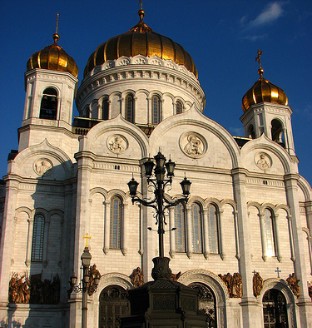Resurrected cathedrals

Imagine a terrifying alternative history of modern Europe: suppose that the Nazis had not only controlled the whole continent but also unleashed a dreadful persecution of the Christian churches. They demolished or desecrated the best-loved monuments of the Christian heritage—St. Peter's in Rome, Notre Dame in Paris, the cathedrals of Canterbury and York. Then, decades later, with the tyranny somehow overthrown, the restored churches begin to restore their lost buildings. The 21st century becomes a new great age of cathedral building, as St. Peter's and the others rise from the rubble. Critics wonder whether the epic restoration scheme rests on any true spiritual foundations, while others argue that resources could be much better employed. But for all the negative sentiment, contemporaries marvel at the soaring affirmations of a reborn faith.
Although that story may seem farfetched, it is a reasonable facsimile of what has occurred in Russia and other nations of the former Soviet Union, which between 1917 and 1941 carried out one of the most savage persecutions in the entire history of Christianity. The Bolsheviks murdered and tortured tens of thousands of clergy, while millions of ordinary believers were slaughtered or starved to death.
The war against God entered a new phase in the 1930s. Determined to prove that religion had wholly lost its grip on the human mind, the Bolsheviks sought to eliminate the most telling visual symbols of the faith, above all the great cathedrals. Dynamite toppled Moscow's huge Cathedral of Christ the Savior in 1931, in an act proudly recorded in propaganda films. The site later became an open-air swimming pool. In 1936, Stalin ordered Red Square cleared of churches, which meant doom for the beloved cathedral church of the Virgin of Kazan. As the assault continued around the country, it claimed such cultural treasures as Odessa's Spaso-Preobrazhensky Cathedral and the Alexander Nevsky Cathedral in Krasnodar. Some houses of worship survived but found humble new roles as warehouses. Although the pressure on the Orthodox Church lightened somewhat after World War II, that was chiefly because the communists no longer saw religion as any kind of serious rival.





